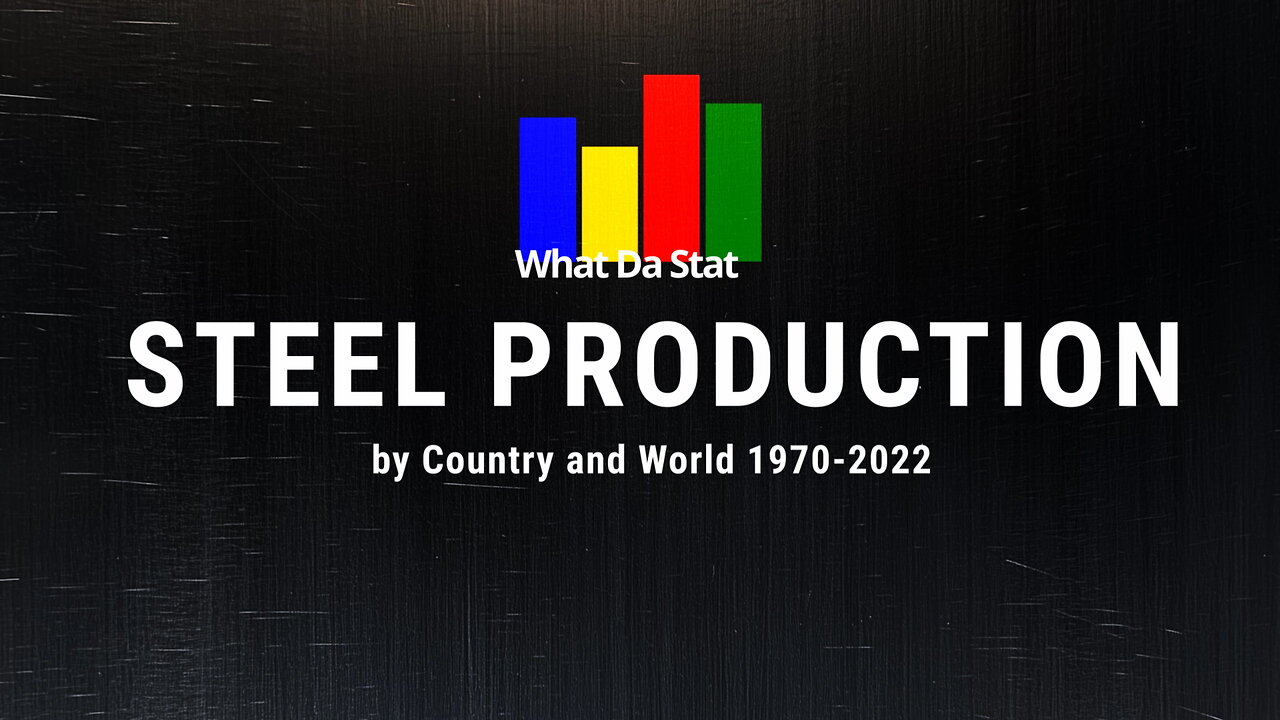Premium Only Content

Steel Producton by Country and World since 1970
This bar chart race shows the annual steel production by country and the world from 1970 to 2022, measured in metric tonnes.
Crude steel production has been a critical component of industrial growth, infrastructure development, and global economic progress. Since 1970, the industry has undergone substantial changes, both in terms of production volumes and the geographical distribution of production.
Global Trends in Steel Production
1970s: Global crude steel production in the early 1970s was around 595 million metric tons annually, dominated by industrial powerhouses like the United States, the former Soviet Union, and Western Europe.
1980s: The industry saw slower growth due to economic recessions and shifts in demand patterns. Annual crude steel production fluctuated between 700 and 770 million tons.
1990s: While the global production stabilized, new players like China and other Asian countries began to rise as manufacturing hubs, contributing to a shift in production centers from Western economies to the East.
The Rise of China (2000-Present)
2000s: China’s economic boom dramatically transformed the global steel industry. In 2000, China produced about 129 million tons of steel, roughly 15% of the global total. By 2010, China's production skyrocketed to over 600 million tons, representing nearly 45% of global output. Global production surpassed 1.4 billion metric tons by the end of the decade.
2010s: China's dominance continued, with the country accounting for more than half of global crude steel production. Global production crossed 1.8 billion tons by 2019, with India also emerging as the second-largest producer, surpassing traditional steel-producing nations like Japan and the U.S.
2020s: In recent years, global crude steel production has faced volatility due to economic disruptions, trade tensions, and the COVID-19 pandemic. However, China has remained the largest producer, with over 50% of the world’s steel output. Global crude steel production in 2022 was around 1.9 billion metric tons, with a focus on sustainability and reducing the carbon footprint of steel production.
Key Geographical Shifts
Europe and North America: Historically dominant, these regions have experienced a relative decline in production as manufacturing shifted to Asia. However, they remain significant producers, with a focus on high-quality steel and technological innovation.
Asia: The biggest transformation in the industry has been the shift to Asia, particularly China, Japan, South Korea, and India. Together, these countries now produce the majority of the world’s steel.
Developing Economies: Nations like Brazil, Turkey, and Vietnam have also seen an increase in steel production as they continue to industrialize and urbanize.
Technological and Environmental Evolution
The steel industry has seen significant technological improvements since 1970. Basic oxygen furnaces (BOFs) and electric arc furnaces (EAFs) have become the primary methods of steel production, with the latter growing in popularity due to its energy efficiency and use of scrap steel.
In recent years, environmental concerns have driven the industry toward reducing carbon emissions. The steel sector accounts for roughly 7-9% of global carbon dioxide emissions, prompting investments in cleaner technologies, such as hydrogen-based steelmaking and carbon capture and storage (CCS).
Steel and the Global Economy
Steel is a crucial material in construction, automotive manufacturing, machinery, and infrastructure. Its demand is closely linked to global economic growth. Periods of high economic expansion, such as China’s infrastructure boom, have led to surges in production, while global recessions, like the 2008 financial crisis, have led to production declines.
Conclusion
Since 1970, global crude steel production has nearly tripled, from around 600 million metric tons to nearly 2 billion tons. The industry has shifted geographically, with China emerging as the dominant player. Looking forward, the focus is on balancing production with sustainability, reducing carbon emissions, and meeting growing global demand.
Data visualization created with Flourish https://flourish.studio
-
 3:54
3:54
Randi Hipper
16 hours ago$100,000 BITCOIN COMING! HERE'S WHY
7871 -
 9:34
9:34
ariellescarcella
9 hours ago"Born This Way Is A Lie" : Religious Debate
392 -
 6:05:13
6:05:13
Akademiks
14 hours agoDay 1/30. Drake Drops lawsuit vs iHeartMedia? Offset and Cardi Calls it Quits. 50 v Jim Jones?
152K12 -
 2:55:11
2:55:11
TimcastIRL
10 hours agoDemocrat TANTRUM At Trump Speech BACKFIRES, Trump Polls UP, Dems UNDER FIRE w/67Kevin | Timcast IRL
196K93 -
 1:25:23
1:25:23
Kim Iversen
12 hours agoFrom Doctor to Political Prisoner: Dr. Simone Gold on COVID Lies, January 6th, and Medical Tyranny
113K69 -
 2:09:28
2:09:28
Melonie Mac
14 hours agoGo Boom Live Ep 39!
71K11 -
 1:04:36
1:04:36
Man in America
16 hours ago🚨 BREAKING: Dr. Robert Young JAILED! Medical Tyrants Will Do ANYTHING to Silence Truth
86K48 -
 3:01:44
3:01:44
I_Came_With_Fire_Podcast
14 hours agoPanama CANAL BlackROCKED | Left of PODCASTING | Ukraine AID GONE
46.9K7 -
 45:56
45:56
Glenn Greenwald
13 hours agoLee Fang Reacts to Trump's Speech to Congress; Will DOGE Tackle Military Waste? | SYSTEM UPDATE #418
111K100 -
 43:23
43:23
Donald Trump Jr.
13 hours agoNo Clap: Dems are a Disgrace but My Father is Bringing Back Common Sense | Triggered Ep.222
164K123